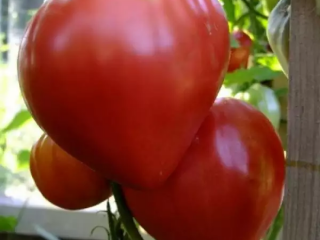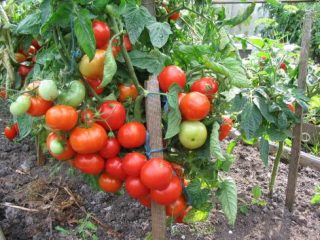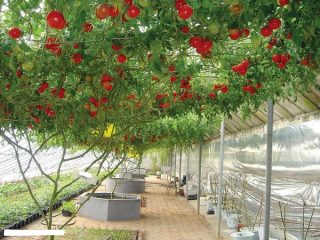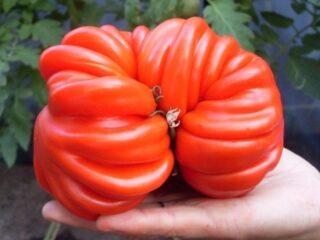Content
The Raspberry Bogatyr tomato is one of the best varieties of tomatoes for growing in the climatic conditions of Russia. The culture is undemanding to growing conditions, resistant to fungal diseases and the harsh climate of Russian regions. Raspberry bogatyr produces large, juicy and very tasty fruits.
History of appearance

The tomato belongs to the determinate variety
The Raspberry Bogatyr tomato variety was developed by the Russian scientist Stepanov V. In 2007, the crop was included in the State Register of the Russian Federation, and it became available to private gardeners for independent cultivation in 2017.
Description and characteristics of tomato variety Raspberry Bogatyr
The Raspberry Bogatyr tomato bushes are medium-sized, growing up to 80-100 cm. The dark green leaves are of medium length, the inflorescences are of a standard yellowish hue.
The fruits are set in clusters on an articulated stalk. They are quite large, have a flat-round shape, more than six nests (chambers).

Fruit weight reaches 480 g
When it ripens
The Raspberry Bogatyr tomato is a mid-early tomato. The crop produces its first harvest 100-110 days after the formation of seedlings.
Tomato yield Raspberry Bogatyr
With proper feeding and timely care of the crop, you can harvest up to 5 kg of tomatoes from each bush, and from 1 sq. m of beds - up to 15 kg.
Disease resistance
The Raspberry Bogatyr tomato has good immunity to diseases, but their prevention will not be superfluous.
Growing regions
Raspberry Bogatyr tomatoes, characterized by fairly large fruits and excellent yield, are suitable for cultivation in both central and southern, as well as northern Russian regions. In areas with colder climates, tomatoes of this variety are grown in greenhouse conditions to obtain a good harvest.

You can harvest many more tomatoes in a greenhouse than when grown in open ground.
Purpose and application
The large Raspberry Bogatyr fruits have a pleasant pulp texture, medium density, they are quite juicy and tasty. I consume these tomatoes fresh, in salads, in various appetizers, and used for preparing hot dishes.
Due to their large size, they are not suitable for rolling into jars entirely. Therefore, Raspberry Bogatyr tomatoes are preserved in pieces, which make very tasty tomato juice, paste and ketchup.
Advantages and disadvantages
Raspberry Bogatyr tomatoes have juicy pulp of medium consistency with a small number of seeds. The fruits have a fairly dense skin that is resistant to cracking.

After harvesting, Raspberry Bogatyr tomatoes can be safely transported over long distances
Pros:
- high productivity;
- large fruits with excellent taste;
- low maintenance;
- resistance to hot weather, drought;
- fairly strong immunity to fungal diseases;
- no gartering of bushes required;
- resistance to cracking due to dense elastic skin;
- possibility of transportation over long distances.
Flaws:
- impossibility of preservation in its entirety due to its large size;
- poor resistance to significant temperature changes;
- increased requirements for soil fertility.
When and how to plant

To get a good harvest of Raspberry Bogatyr tomatoes, the crop is grown using seedling technology
Seeds are sown two months before planting in the ground at a permanent place of growth.
Tomato seedlings are placed on an open plot of land after the cessation of night frosts, when the soil warms up sufficiently - up to 10-12ºС.
To grow tomatoes in a greenhouse, the soil is prepared in advance:
- in late autumn, the soil is thoroughly cleaned of household and plant residues;
- add organic fertilizers - compost, humus, poultry droppings, manure;
- The soil is carefully dug up.
It is not recommended to add fresh manure to the soil in the spring before planting seedlings. It can simply burn the still rather weak root system of the crop.
The Raspberry Bogatyr tomato grows well in light, fertile soil. It is humus, but not fresh manure, that makes the soil loose, well permeable to air, incl. capable of aeration.
If you plan to grow tomatoes on an open plot of land, it is recommended to plant seedlings after legumes, cucumbers, carrots or onions. In greenhouse conditions, you can alternate planting sites for tomatoes and cucumbers.

Tomato seedlings of the Raspberry Bogatyr variety are planted in pre-prepared holes in loosened soil
To fill the holes, prepare treated and fertilized soil, which is mixed with wood ash, humus and superphosphate.
Young plants are planted in holes, covered with fertilized soil and lightly compacted around the stem. After planting the seedlings, water the soil abundantly with water.
Rules of care
The Raspberry Bogatyr tomato is unpretentious for growing both on open land plantations and in greenhouse conditions. But the basic rules of crop care and disease prevention must be followed in order to get a good harvest.
Before sowing, Raspberry Bogatyr tomato seeds must be disinfected, for example, with a solution of potassium permanganate or other antiseptic. After this, the seeds are placed in a growth stimulator for 24 hours.

When the seeds sprout, a complex mineral fertilizer is introduced into the soil, which includes potassium and phosphorus.
The potassium concentration in the fertilizer is increased during the flowering of the crop and during the formation of fruit ovaries.
After planting the seedlings in a permanent place, the soil is periodically watered. It should always be slightly moist, the main thing is to avoid drying out.During the dry season, when there is no rain at all, tomatoes can be watered daily. Under normal conditions, 2-3 times a week is enough.
Also, when growing Raspberry Bogatyr tomatoes, it is important to properly form the bushes of the crop. Such events include:
- leaf trimming;
- topping;
- stepsoning;
- rationing of ovaries.
Experienced gardeners use eggshells, bird droppings, yeast, and iodine for feeding.

At each stage of growth, it is necessary to provide the crop with the required microelements - organic and mineral supplements.
Treatment against diseases and pests
In the process of growing Raspberry Bogatyr tomatoes, an important component is sufficient watering of the plants, but without excess. This will prevent many plant diseases. Also, tomato bushes must be treated in a timely manner with special preparations against harmful insects.

The most common disease of all tomato varieties is late blight.
To prevent the occurrence of a fungal disease, not only the plant itself is treated, but also the soil, working tools, incl. polycarbonate walls of the greenhouse.
The remedy for late blight recommended by experienced gardeners is “Fitosporin”. The crop is sprayed with this preparation before the formation of inflorescences, then after the formation of fruit ovaries.
Quite common fungal diseases of vegetable crops are anthracnose, cercospora and alternaria.

For prevention, it is recommended to treat plants with copper sulfate and Bordeaux mixture.
Also, Raspberry Bogatyr tomato bushes can suffer from viral diseases (spotted wilt, tobacco mosaic). Prevention of these diseases is recommended to be carried out immediately, becauseaffected crops will no longer be curable. To do this, the soil is treated with fungicides before planting seedlings. Experienced gardeners recommend buying a special antiviral drug “Aktara”.

The Raspberry Bogatyr tomato must be treated with special compounds against various insects and pests

Gardeners fight gastropods (slugs) with homemade tinctures based on pepper, garlic or mustard
The following drugs have also proven themselves to be effective: “Thunder” and “Ulitsid”.
Ants, which are carriers of aphids, also greatly annoy vegetable crops. These insects are fought with the help of granular Anteater composition, which is scattered around the bushes.
To save Raspberry Bogatyr tomatoes from being eaten by aphids, it is recommended to use the following preparations: Fufanon, Fitoverm or an ammonia soap solution.

The horse system of vegetable crops attracts nematodes - roundworms. The following chemicals are intended to combat them: “Fitoverm”, “Nematofagin”, “Karbofos”

Special chemical compounds “Biotlin”, “Iskra”, “Tanrek” help to fight the whitefly, which leaves larvae under the green leaves of the crop and sucks all the juices from the plant.
Conclusion
The Raspberry Bogatyr tomato is one of the most popular varieties among Russian gardeners. It does not require any special care and grows well in the harsh climatic conditions inherent in different regions of Russia. It is enough to follow standard procedures for growing vegetable crops: disease prevention, timely fertilizing, watering the soil.Following these simple rules will allow any gardener to harvest a good harvest of large, fleshy and juicy tomatoes.
Reviews from gardeners about the Raspberry Bogatyr tomato








